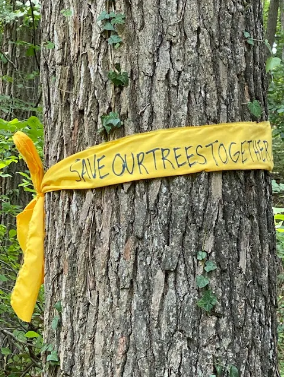The Woods in Winter Highlight the Ivy Problem
By Nina Fisher (Class 5 Watershed Steward, WSA Board member and co-founder of Save Our Trees)
Take a look at the woods in winter. Now, really scrutinize them. Most of the trees are bare, shorn of their summer green garb, awaiting the warmish breaths of spring. The conifers and hollies stand out as they hold on to their dark green foliage.
This description is how the woods should look...but many do not. High up in many deciduous trees is a tangle of green English ivy and other invasive vines. It’s easy to see at this time of year and immediately alerts you to this serious problem in our forests.
The scope of the problem is enormous. When you drive around our county, there are very few places not compromised by these horrid invasive vines—English ivy, bittersweet, Japanese honeysuckle, porcelain berry and others. The vines wrap around tree trunks, holding moisture against the bark. They suck up nutrients and water that could go to the trees. They add enormous weight that the trees must support and make them more likely to topple during storms. They crowd out the native plants upon which our wildlife depends.
The problem seems overwhelming.
I am a co-founder of Save Our Trees (now a program under WSA), an organization that started when five concerned women got together just under three years ago because we wanted to do SOMETHING about this menace. And we have. In under three years, we and our volunteers have cleared almost 7,000 trees of these vines.
Is it a drop in the bucket? Yes. Does it make a difference? To every one of those 7,000 trees it does.
We take a “Just One Tree” approach. You may not be able to clear an entire forest of invasive vines, but you can clear just one tree. And after that, another tree. Every tree matters.
So, here is our ask. When you are walking around your yard or your neighborhood, we ask that you view the trees in a new light. Look for the vines. Then, get your pruners and start clipping. (see how at www.saveourtreestogether.org/resources/removing-ivy/). If the tree is not on your own property, get permission from the community or landowner first.
Your tree will thank you. Really! If you listen carefully, you can hear a huge sigh of relief.
We also ask that you count every tree that you free from vines and report the number to us. Our goal for the end of our third year is to reach 10,000 trees. We have a long way to go but with community help, we can get there.
If you become really enthused about removing vines, Save Our Trees is happy to help you run a neighborhood event. We have a short guide to setting up such an effort on our website (www.saveourtreestogether.org). We will also come to the event to demonstrate proper removal techniques and to help clear vines.
Save Our Trees wants the act of removing vines to ripple across the county so that more and more people understand the harm vines cause and the actions they can take in their own yards and communities.
Please reach out to us at saveourtreestogether@gmail.com and let us know how we can help you tackle this widespread problem. Every tree saved will thank you.

